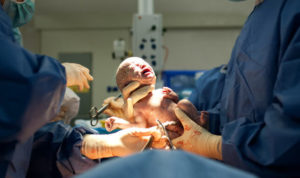How Common Is Erb’s Palsy?
As many as 2 of 1,000 babies are born with Erb’s palsy each year in the United States.
“Erb’s palsy occurs in 0.9 to 2.6 per 1,000 live births or nearly 12,000 cases per year.”
– Cleveland Clinic
- Erb’s palsy is a type of birth injury that is also known as brachial plexus birth palsy and Erb-Duchenne paralysis.
- The condition can affect 1 or all of the 5 main nerves that allow people to move and feel their arms.
- Erb’s palsy paralysis can be either partial or total in the affected arm.
- Three therapies used to treat Erb’s palsy are occupational therapy, physical therapy, and physiotherapy.
- Erb’s palsy lawsuits often result in settlements of $1 million or more.
What Are Some Causes of Erb’s Palsy?
Erb’s palsy cases are most common in babies with shoulder injuries sustained from birth trauma connected to a difficult delivery.

Health care professionals can cause Erb’s palsy by:
- Improperly using assistive birthing equipment such as forceps or vacuum extractors
- Delivering a baby vaginally instead of performing a Cesarean section (C-section)
- Failing to have a safety plan for a high-risk delivery
- Using too much force to deliver a baby from the birth canal
These medical mistakes are often considered medical malpractice.
Families affected by Erb’s palsy should speak to an Erb’s palsy lawyer to find out if their child’s condition was caused by medical malpractice. If so, they could be entitled to compensation. Contact one of our team members right now for a free case review.
Types of Brachial Plexus Palsy
Even though Erb’s palsy is only one kind of brachial plexus palsy, it has the highest incident rate.
Erb’s palsy accounts for approximately 75% of all brachial plexus injuries.
Here are some other types of neonatal brachial plexus palsy:
- Avulsion: This occurs when the nerve root is torn from the spinal cord. It is the most severe type of brachial plexus palsy.
- Horner’s syndrome: This condition, which is caused by nerve damage that affects the eye, is often characterized by a drooping eyelid.
- Klumpke’s palsy: This injury is caused by nerve damage in the lower arm. It impacts mobility in the hand and wrist and is extremely rare.
- Neurapraxia: The nerve has been stretched and injured but not torn.
- Neuroma: Scar tissue has formed around the injury, preventing the nerve from communicating with the muscles.
- Rupture: The nerve has been torn but not where it connects to the spinal cord.
Depending on the type and severity of a child’s obstetric brachial plexus palsy, they may recover with minimal treatment or need invasive medical interventions.
In more severe cases of Erb’s palsy, children may need to undergo:
- Nerve grafts
- Nerve transfers
- Tendon transfers
What Are Risk Factors for Erb’s Palsy?
Many risk factors can play a role in Erb’s palsy in a newborn.
These risk factors include:
- Birth weight more than 8 pounds, 13 ounces (macrosomia)
- Breech delivery (baby positioned feet or buttocks first in the uterus)
- Maternal diabetes or obesity
- Medications like oxytocin or an epidural given during labor
- Prolonged labor (more than 60 minutes)
- Shoulder dystocia (one or both of a baby’s shoulders get stuck during childbirth)
A 2023 medical report identified high infant birth weight and shoulder dystocia as the two greatest risk factors for Erb’s palsy.
To get started with a free case review of your child’s Erb’s palsy claim, call (888) 726-9160 today.
What Is the Recovery Rate for Erb’s Palsy?
Most children make a full recovery from Erb’s palsy either on their own or with early treatment. Physical therapy can help children recover range of motion in their arm.
“Fortunately, between 80% to 90% of children with such injuries will attain normal or near normal function.”
— Wheeless’ Textbook of Orthopaedics
Here are some other Erb’s palsy statistics on recovery:
- About two-thirds of children with a brachial plexus birth injury get better with minimal treatment.
- Infants who are able to bend their elbow by the third month of life are likely to recover from Erb’s palsy as are babies who can move their wrist upward and straighten their fingers and thumb.
- If the condition hasn’t improved by the time an infant is 6 months of age, surgery might be needed to repair the injured nerves and muscles.
- It can take children up to 2 years to fully recover from Erb’s palsy nerve damage.
- Complete recovery is unlikely if an infant hasn’t shown any improvement in the first 2 weeks of life.
- Recovery is close to 100% when children receive treatment within the first 4 weeks of birth.
Erb’s Palsy Verdict & Settlement Statistics
 When an Erb’s palsy nerve injury is caused by medical negligence by a doctor, nurse, or hospital, parents may decide to file an Erb’s palsy lawsuit to pursue compensation to care for their child. A lawsuit may result in an Erb’s palsy settlement or verdict.
When an Erb’s palsy nerve injury is caused by medical negligence by a doctor, nurse, or hospital, parents may decide to file an Erb’s palsy lawsuit to pursue compensation to care for their child. A lawsuit may result in an Erb’s palsy settlement or verdict.
The amount of Erb’s palsy settlements and verdicts vary depending on the severity of injury, amount of permanent impairment, and many other factors.
Like many other types of birth injury lawsuits, Erb’s palsy suits often result in payouts of $1 million or more.
Here are some notable Erb’s palsy settlements and verdicts:
- $12.9 million verdict to a Michigan family in a case involving shoulder dystocia
- $6 million settlement to a family in a case involving three avulsions
- $3.5 million verdict to a New York family in a case involving shoulder dystocia
- $850,000 settlement to a Pennsylvania family in a case involving failure to detect fetal distress
An Erb’s palsy lawyer can give you an idea about the potential value of your child’s Erb’s palsy claim.
Learn More About Erb’s Palsy Legal & Financial Aid
After learning more about Erb’s palsy statistics, you may have questions about your child’s birth injury or how you’re going to pay for their care.
Our team at LawFirm.com is here to help. We can connect you with legal and financial resources if you qualify.
Contact us today for a free and confidential consultation.
 Get Legal Help Now
Get Legal Help Now
